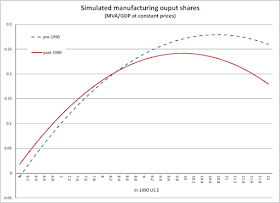Dani Rodrik has a new working paper on premature de-industrialization that highlights the challenge facing countries like India which have staked its growth on manufacturing. He examines the trends in the shares of manufacturing employment (manemp), nominal manufacturing value added (nommva), and real manufacturing value added (realmva) for a sample of 42 developed and developing countries over a long period from late 1940s to early 2010s.
Controlling for various factors, including period and country fixed effects, his regression results point to a much larger effect of premature de-industrialization on manemp than on realmva. For a representative country with median population in the sample (27 million), the manemp peaks at much lower income levels than realmva. The manemp starts to fall after peaking at about 20% at an income level of $5500, while realmva peaks much higher and at a much later stage (in fact at $70000 per capita income). Since the relative price of manufacturing declines as countries get richer, the nommva peaks earlier than realmva.
His model also points to a strengthening of the premature de-industrialization trend among economies since the 1990s. For the representative economy, since 1990 the share of manufacturing employment tends to peak at earlier income levels and at a lower rate.
The same trend is observed for manufacturing output in recent decades.
Interestingly, Prof Rodrik finds that these trends are less strong for countries, especially from East Asia, who have had a comparative advantage in manufacturing.
These trends can be possibly explained by a combination of two arguments. The demand-side argument is that consumption preferences shift away from goods and towards services as incomes grow. This would cause a shift away from manufacturing in both employment and value added. The supply-side argument is that in view of technological progress and its impact on manufacturing productivity, the elasticity of substitution of labor between manufacturing and other sectors is less than one. However, while this causes the employment share to decline, the share of value added keeps rising.
Controlling for various factors, including period and country fixed effects, his regression results point to a much larger effect of premature de-industrialization on manemp than on realmva. For a representative country with median population in the sample (27 million), the manemp peaks at much lower income levels than realmva. The manemp starts to fall after peaking at about 20% at an income level of $5500, while realmva peaks much higher and at a much later stage (in fact at $70000 per capita income). Since the relative price of manufacturing declines as countries get richer, the nommva peaks earlier than realmva.
His model also points to a strengthening of the premature de-industrialization trend among economies since the 1990s. For the representative economy, since 1990 the share of manufacturing employment tends to peak at earlier income levels and at a lower rate.
The same trend is observed for manufacturing output in recent decades.
Interestingly, Prof Rodrik finds that these trends are less strong for countries, especially from East Asia, who have had a comparative advantage in manufacturing.
These trends can be possibly explained by a combination of two arguments. The demand-side argument is that consumption preferences shift away from goods and towards services as incomes grow. This would cause a shift away from manufacturing in both employment and value added. The supply-side argument is that in view of technological progress and its impact on manufacturing productivity, the elasticity of substitution of labor between manufacturing and other sectors is less than one. However, while this causes the employment share to decline, the share of value added keeps rising.



No comments:
Post a Comment